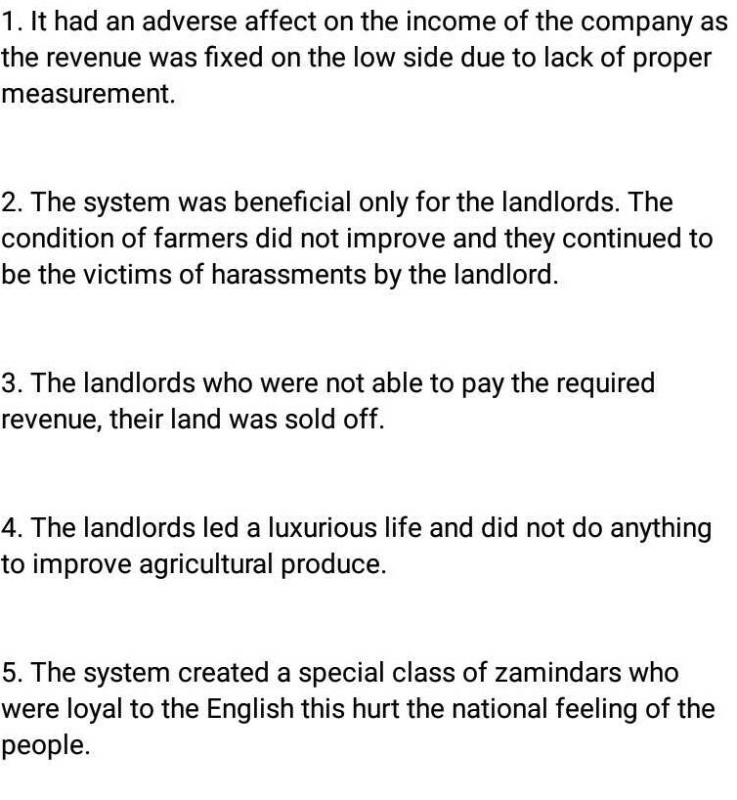Class 8 Exam > Class 8 Questions > What were the problems raised due to permanen...
Start Learning for Free
What were the problems raised due to permanent settlement system ?
Most Upvoted Answer
What were the problems raised due to permanent settlement system ?

Community Answer
What were the problems raised due to permanent settlement system ?
Problems Raised due to Permanent Settlement System
The Permanent Settlement System, also known as the Zamindari System, was introduced in India by the British East India Company in 1793. This system aimed to fix the revenue demand of the land and establish a permanent relationship between the zamindars (landlords) and the British government. However, the implementation of this system led to several problems, including:
1. Exploitation of Peasants
The Permanent Settlement System resulted in the exploitation of peasants. The zamindars, who were given the responsibility of collecting revenue from the peasants, often imposed exorbitant taxes to maximize their own profits. This led to the impoverishment of the peasants and their inability to pay the high taxes, causing widespread agrarian distress.
2. Absentee Landlords
Under the Permanent Settlement System, the zamindars became the owners of the land. Many of these landlords were absentee landlords who resided in cities or distant places and had no direct connection with the farmers. As a result, they showed little interest in the welfare and development of the land, leading to neglect and deterioration of agricultural practices.
3. Decline in Agricultural Productivity
The Permanent Settlement System created a disincentive for the zamindars to invest in agricultural improvements. Since their revenue was fixed, they had no motivation to invest in irrigation, soil conservation, or modern farming techniques. Consequently, agricultural productivity declined, leading to a decrease in overall agricultural output.
4. Social and Economic Inequality
The Permanent Settlement System exacerbated social and economic inequality. The zamindars, who became the intermediaries between the British government and the peasants, amassed immense wealth and power. They formed a privileged class, while the peasants were burdened with heavy taxes and indebtedness. This created a stark divide between the rich and the poor, widening the existing social and economic disparities.
5. Resistance and Rebellion
The implementation of the Permanent Settlement System faced significant resistance and rebellion from the peasants. They protested against the high taxes, exploitation by zamindars, and the overall oppressive nature of the system. These uprisings, such as the Indigo Rebellion and the Santhal Rebellion, reflected the discontent and frustration of the peasants, leading to social unrest and a challenge to British authority.
Overall, the Permanent Settlement System had detrimental effects on the peasantry, agricultural productivity, social equality, and political stability in India. It perpetuated the exploitative nature of colonial rule and contributed to the grievances that fueled the Indian independence movement in the following decades.
Attention Class 8 Students!
To make sure you are not studying endlessly, EduRev has designed Class 8 study material, with Structured Courses, Videos, & Test Series. Plus get personalized analysis, doubt solving and improvement plans to achieve a great score in Class 8.

|
Explore Courses for Class 8 exam
|

|
Similar Class 8 Doubts
What were the problems raised due to permanent settlement system ?
Question Description
What were the problems raised due to permanent settlement system ? for Class 8 2024 is part of Class 8 preparation. The Question and answers have been prepared according to the Class 8 exam syllabus. Information about What were the problems raised due to permanent settlement system ? covers all topics & solutions for Class 8 2024 Exam. Find important definitions, questions, meanings, examples, exercises and tests below for What were the problems raised due to permanent settlement system ?.
What were the problems raised due to permanent settlement system ? for Class 8 2024 is part of Class 8 preparation. The Question and answers have been prepared according to the Class 8 exam syllabus. Information about What were the problems raised due to permanent settlement system ? covers all topics & solutions for Class 8 2024 Exam. Find important definitions, questions, meanings, examples, exercises and tests below for What were the problems raised due to permanent settlement system ?.
Solutions for What were the problems raised due to permanent settlement system ? in English & in Hindi are available as part of our courses for Class 8.
Download more important topics, notes, lectures and mock test series for Class 8 Exam by signing up for free.
Here you can find the meaning of What were the problems raised due to permanent settlement system ? defined & explained in the simplest way possible. Besides giving the explanation of
What were the problems raised due to permanent settlement system ?, a detailed solution for What were the problems raised due to permanent settlement system ? has been provided alongside types of What were the problems raised due to permanent settlement system ? theory, EduRev gives you an
ample number of questions to practice What were the problems raised due to permanent settlement system ? tests, examples and also practice Class 8 tests.

|
Explore Courses for Class 8 exam
|

|
Suggested Free Tests
Signup for Free!
Signup to see your scores go up within 7 days! Learn & Practice with 1000+ FREE Notes, Videos & Tests.

























